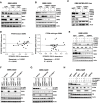Coordinated Targeting of S6K1/2 and AXL Disrupts Pyrimidine Biosynthesis in PTEN-Deficient Glioblastoma
- PMID: 39087397
- PMCID: PMC11342319
- DOI: 10.1158/2767-9764.CRC-23-0631
Coordinated Targeting of S6K1/2 and AXL Disrupts Pyrimidine Biosynthesis in PTEN-Deficient Glioblastoma
Abstract
Intrinsic resistance to targeted therapeutics in PTEN-deficient glioblastoma (GBM) is mediated by redundant signaling networks that sustain critical metabolic functions. Here, we demonstrate that coordinated inhibition of the ribosomal protein S6 kinase 1 (S6K1) and the receptor tyrosine kinase AXL using LY-2584702 and BMS-777607 can overcome network redundancy to reduce GBM tumor growth. This combination of S6K1 and AXL inhibition suppressed glucose flux to pyrimidine biosynthesis. Genetic inactivation studies to map the signaling network indicated that both S6K1 and S6K2 transmit growth signals in PTEN-deficient GBM. Kinome-wide ATP binding analysis in inhibitor-treated cells revealed that LY-2584702 directly inhibited S6K1, and substrate phosphorylation studies showed that BMS-777607 inactivation of upstream AXL collaborated to reduce S6K2-mediated signal transduction. Thus, combination targeting of S6K1 and AXL provides a kinase-directed therapeutic approach that circumvents signal transduction redundancy to interrupt metabolic function and reduce growth of PTEN-deficient GBM.
Significance: Therapy for glioblastoma would be advanced by incorporating molecularly targeted kinase-directed agents, similar to standard of care strategies in other tumor types. Here, we identify a kinase targeting approach to inhibit the metabolism and growth of glioblastoma.
©2024 The Authors; Published by the American Association for Cancer Research.
Conflict of interest statement
No disclosures were reported.
Figures





References
-
- Wirsching H-G, Galanis E, Weller M. Glioblastoma. Handb Clin Neurol 2016;134:381–97. - PubMed
Publication types
MeSH terms
Substances
Grants and funding
LinkOut - more resources
Full Text Sources
Molecular Biology Databases
Research Materials
Miscellaneous

